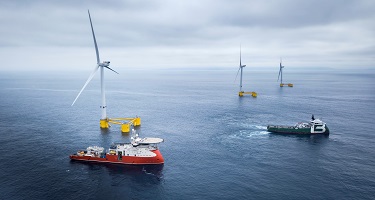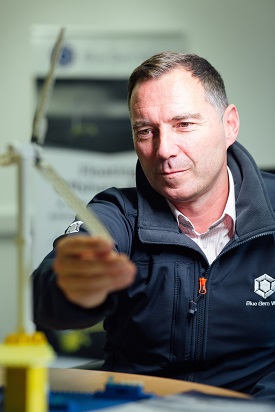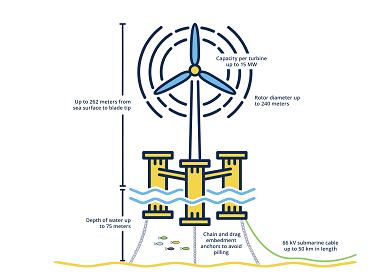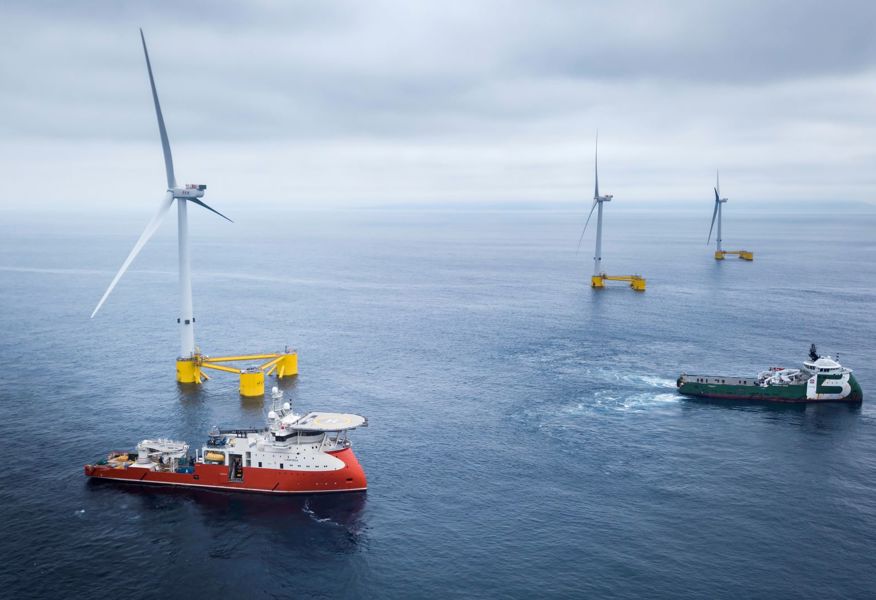
Thanks to a Pembrokeshire based company, it’s hoped huge floating wind turbines will soon join their ‘fixed bottom’ cousins making offshore wind power the most significant player in the UK’s move to zero carbon electricity. But what do Blue Gem Wind’s plans mean for Pembrokeshire?
The pace at which renewable energy technologies have emerged and evolved in the last decade is astonishing. The urgency of the situation we face, emphasised by the avalanche of projections mapping climate change, has prompted governments to provide financial incentives to developers, keen to narrow down the list of likely technologies that can supply zero carbon electricity within just a few years.
Pembrokeshire has felt the tremors of this emerging sector, partly due to the Port’s facilities and location next to outstanding wind, wave and tidal resources, and partly due to the talent and intent of local fabricators, agencies and businesses who see so much potential for the regional economy. We have seen a range of tidal and wave devices, some featured in this magazine, constructed and trialled on and around the Waterway. However, one technology has leapfrogged all the others to become the frontrunner in the race to deliver clean, green electricity from the sea and onto Pembrokeshire’s shores: floating offshore wind or FLOW.
It’s a simple concept, once you take for granted the brilliance of the scientists and engineers who created and constructed the wind turbines capable of surviving some of the world’s most hostile environments, and once you have given a substantial nod to the oil and gas industry that made the idea of giant, floating platforms anchored to deep seabeds and connected to thick power cables seem, well, almost humdrum. Then there are the investors, putting many millions of pounds into this technology at some risk.
Earlier this year, Blue Gem Wind, a company that emerged from a joint venture between French energy giant TotalEnergies and Irish/UK marine energy developer Simply Blue Energy, announced they were launching a project to build wind farms in the Celtic Sea off the coast of Pembrokeshire.
So why wind turbines and why here?
Wind power is one of the big success stories of renewable energy in the UK, which is a world leader in the sector. It contributed a quarter of all electricity supplied in the UK last year. Just under half of that capacity is offshore but the government wants more of it, four times more, by 2030.
The relatively shallow waters off the east and south coasts of England – most less than 50m deep - made it possible to install fixed bottom turbines to the seabed. However, off West Wales’ coastline the sea floor plunges to depths between 60 and 150m very close to land. As David Jones, Stakeholder Manager at Blue Gem Wind, explained that represents both a challenge and a huge opportunity.
“80% of the world’s wind resource can be found in water deeper than 60 metres,” explained David. “That is why floating wind will become a key technology in the fight against climate change. Moving offshore into deeper waters also brings other benefits, it is where wind speeds are higher, meaning you get more energy. There is also less visual impact and fewer potential conflicts with other marine users. In fact, with between 150 – 250 GW of wind resource off the coast of Southern Ireland, Wales and the southwest of England you could say the Celtic Sea was made for floating wind. That’s why we are here."
“It’s worth mentioning, too,” he continued, “that Pembrokeshire has port facilities that could support deployment, operation and maintenance and there is the connectivity to deliver electricity to the rest of the UK via the National Grid.”
Blue Gem Wind, based at the Bridge Innovation Centre in Pembroke Dock, has been very busy over the last 18 months. Last August they secured a lease from the Crown Estate (which manages the seabeds around the UK), for an area 44 kilometres off Pembrokeshire. This will be where they will site their first wind farm ‘Erebus’, a 96MW demonstration project which will provide enough green energy for 90,000 homes and is due to be completed in late 2026. The lease enabled them to proceed with scoping and completing the public consultation, surveys and environmental assessments this year, ahead of a formal planning application.
“As 2021 comes to a close, we can take stock as a team on the verge of a very exciting time,” said Mike Scott, Project Managing Director at Blue Gem. “We have a challenging mission and a timeline that will see the commissioning of the UK’s largest offshore floating wind array within 5 years.”
It’s ok to be excited about what Blue Gem Wind has planned. Projects like this will form a significant part of our response to the climate crisis. In fact, offshore wind will do more to decarbonise the UK’s electricity use than any other technology. But there’s even more enthusiasm around what this company’s pioneering work could mean for Pembrokeshire. Tim James, Head of Energy Development at the Port of Milford Haven has been working with Blue Gem Wind to see how the Port’s Pembroke Dock Marine project can serve and support the emergence of FLOW.
“The UK is already a world leader in offshore wind, with more turbines installed than any other country,” said Tim. “Already the sector has a workforce of over 25,000 people, most of them in the east of England. Floating offshore projects in the Celtic Sea off Pembrokeshire will make a huge contribution to the extra 30GW of offshore energy expected by the government by 2030, at which point they predict 70,000 people will be working in the sector. Thanks to Blue Gem Wind and others who follow them, many of those jobs could be right here.”
So, what sort of jobs will there be?
“If we can work with the Port to develop a way to mount the turbines on the platforms at Pembroke Port then we can expect the sort of activity in the docks that perhaps hasn’t been seen since its shipbuilding days,” explained David. “That’s going to be a challenge, of course, when you consider the turbines are up to 265m high and their platforms 100m in length!”

"There is also a range of other activity that could be captured here, such as operations and maintenance, that will create new green jobs.”
“We feel a stepping-stone approach to developing floating wind in the Celtic Sea is critically important,” David continued. “This is the best way to start a new industry: start with small projects, like Erebus, before moving to larger projects. This will give the local supply chain the best possible chance to grow with the sector.”
Although the floating platforms are designed to be ‘plug and play’, there will be a lot of undersea preparation needed to anchor the devices in place. Then there is the electricity cabling. A 50 km subsea cable will be laid from the ‘Erebus’ site to make landfall between Freshwater West and West Angle Bay. From there the cable will be buried underground to Pembroke Power Station and joined to the National Grid network via a new substation.
Blue Gem Wind is, for now, a small company with big plans. It employs just 30 people but will have to recruit rapidly as the project unfolds. For David, however, this past year has been a very rewarding time. He came to this job after more than a decade working to stimulate the marine renewables industry in Wales at Marine Energy Pembrokeshire (which became Marine Energy Wales).
“I’ve spent over 10 years promoting Pembrokeshire and Wales as a place ideally suited to developing offshore energy. As we now enter the most important decade in terms of climate action, I’m thrilled that floating wind is on the cusp of taking off in the region.”
MEET THE WINDFLOAT®
Erebus will see 6 – 10 giant WindFloat® platforms around 100m wide, positioned around 27 miles off the coast of Pembrokeshire within an area of around 32km2 .
A huge wind turbine will be placed on each semi submerged platform, with a blade diameter that could be up to 240m (the equivalent of nearly two and a half rugby pitches!) making the total structure’s height from sea level twice the height of the London Eye.
There are currently three WindFloat® platforms deployed in an array off the coast of Portugal. They were manufactured by Principle Power Inc in shipyards in Portugal and Spain.

“The WindFloat Atlantic project in Portugal was a world first and started delivering electricity last year using this platform. It is proving itself already,” said David Jones. “’Erebus’ will be a stepping stone project and we already have plans to follow it with a second, ‘Valourous’, which will see 18-31 platforms generating up to 300MW of electricity by 2028.”
The ‘Erebus’ wind turbines will provide enough green energy for 90,000 homes per year, more than all the homes in Pembrokeshire. They will have a minimum operating life of 25 years.


